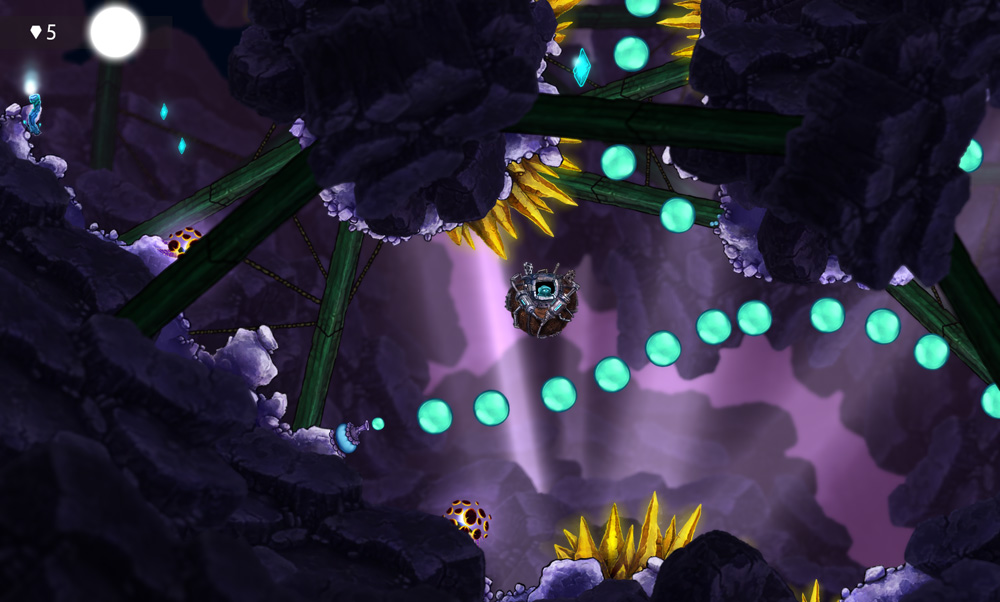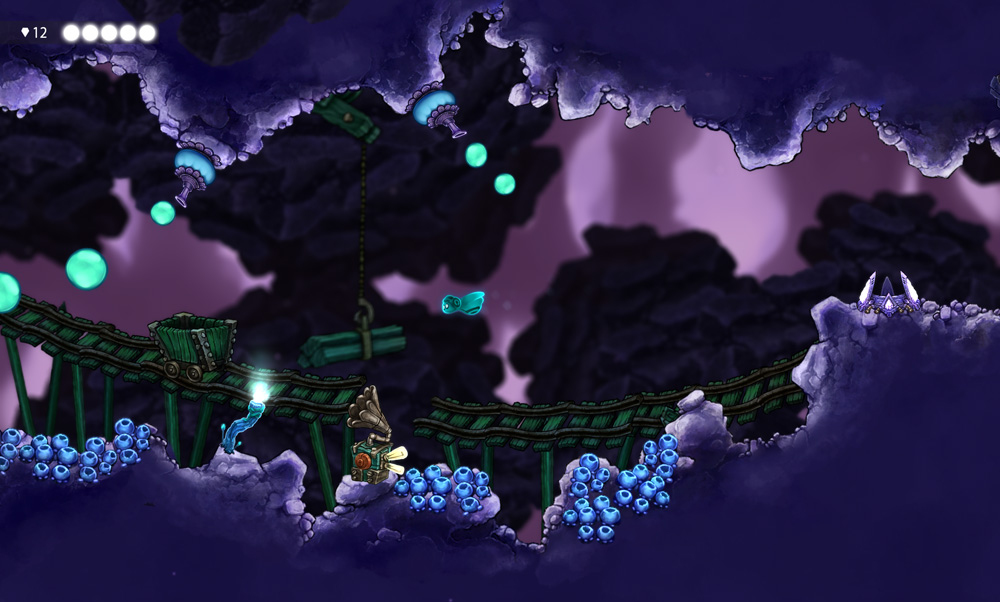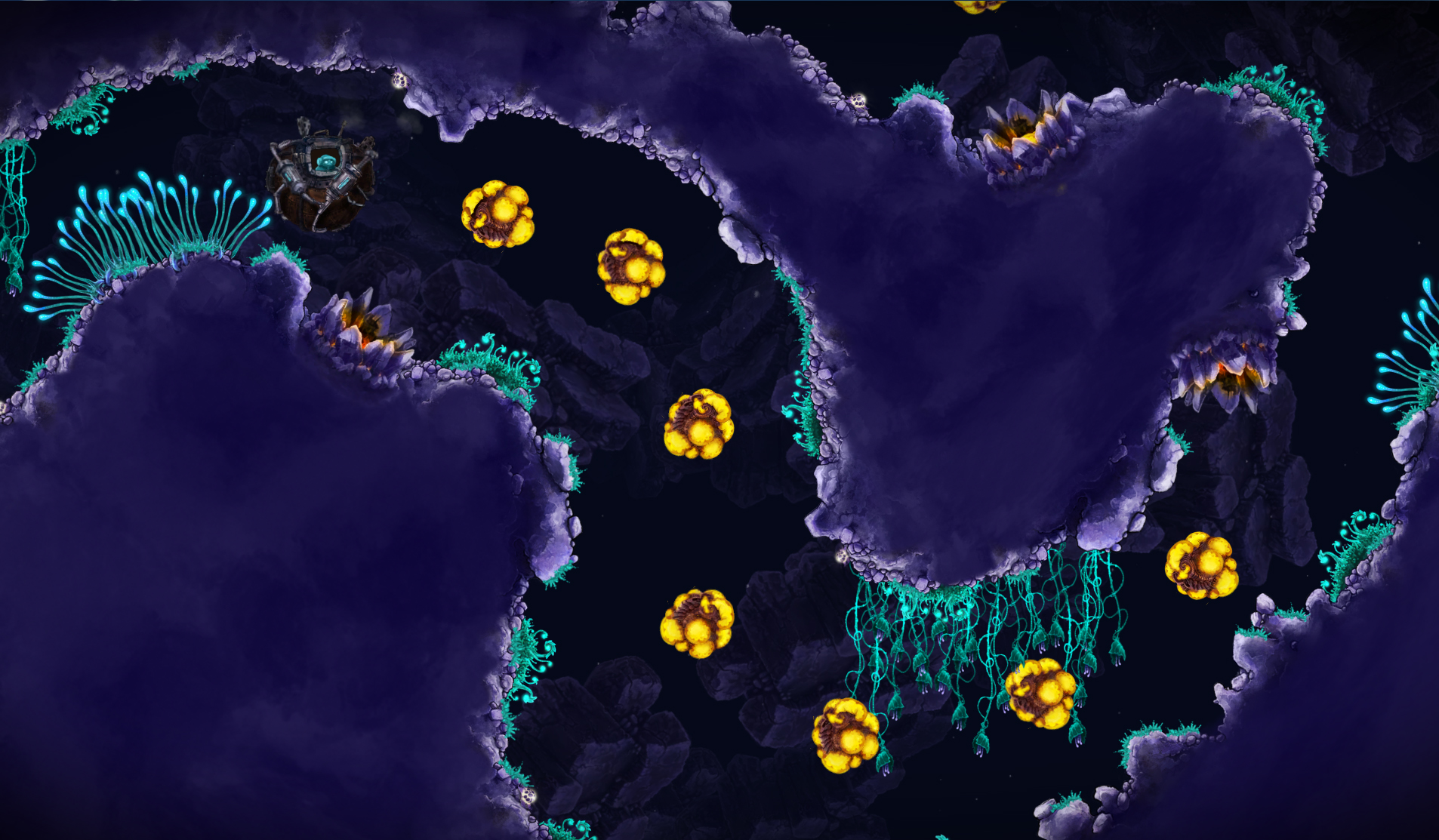Busting a groove with Beatbuddy
The 2013 PAX East show floor was rife with crazy crowds clamoring for a chance to play the big games, but one odd figure stood out from the crowds. Imagine if Barney the Dinosaur had a little brother who forewent the path of children’s education and instead pursued hip beats, melodies and orchestrations of the newest, coolest music. That was Beatbuddy, the instantly lovable yet perplexing character rocking the show floor.
Nobody knows exactly who or what Beatbuddy is, but we do know that he lives inside a world where everything is musical. However, the Prince of Music, monarch of the music world, is so caught up in his fame and glory that he neglects a treacherous infestation of parasites corrupting the natural music ecosystem. Now, it’s up to Beatbuddy to step in and restore harmony (literally) to the land.
Coming from an independent company that endearingly refers to itself as Threaks (“three freaks”), Beatbuddy is a project that has been in development for more than three years. Over the course of its growth it has managed to scrape up plenty of recognition, including a finalist nomination for the German Computer Game award in 2011 and an Honorable Mention at the Independent Games Festival for Excellence in Audio in 2012. At PAX East, we got to play the game and see what those three years of work have amounted to.
“It just went from iteration to iteration,” vented a Threaks co-founder Wolf Lang. “Sometimes we had too much music and too little game, sometimes we had too much game and too little music. It was really hard to find the balance, it took us a lot of time. But in the meantime, we got an honorable mention at the IGF for best art and best sound, so we knew we were on the right track. It took us the last 15 months to come up with this final build that we are playing here. The feedback yesterday was so awesome, we were so happy that all the 14,000 kilometers we traveled here was worthwhile.”
In the tutorial of Beatbuddy, we swam through a lush blue cavern full of sea creatures bopping to the level’s beat. Everything in the game is hand-drawn and has a charm similar to Rayman Origins. Drum-like anemones bounce Beatbuddy through the crevices with a cymbal crash, propelling him through the caves. Color-changing bubbles block you unless you swim through them on the beat. Hermit crabs clickity-clack on the rocks while snails groove with spikes poking from their shells. Hit the crab, and the snails retract their spikes to open the way across. You have to swim quickly, though, because a drum roll means they’re about to pop out again. In Beatbuddy, the soundtrack doesn’t just provide the music; it directs environmental hazards and enemies, ultimately controlling the way forward.
“We developed a sound technology that entered patent pending two weeks ago,” Lang proudly told us. “What’s happening is that all the sounds that you’re hearing at the same time, and all the animation with it, is generated in real time. So, we have a very low performance playing 10 to 12 tracks at the same time. That hasn’t been done before because in other games you basically have the MP3 and just filter out the piece — that’s all you can do. But we worked together so closely with the musicians, so we have all the different parts and we can trigger them one by one.”
Further into the level, we came across a round, wooden contraption: the Beatmobile. It moves, as you might imagine, to the beat, inching along with each pulse. Lang explained: “This is how the game started three years ago, with the idea of, ‘How would it be if you could only move to the bass drum beat, and everything else moved to different beat patterns? What would it be like?’ But then after we iterated, we realized that might be a bit too boring to move only one beat forever, so we thought, ‘How can we do it differently?'”
The solution was to mix up level traversal. After working through the first verse of the level, we popped into the Beatmobile to zip around while the chorus kicked the music up a notch. Often, this would involve swimming through narrower places to open doors before proceeding with the Beatmobile.
Beatbuddy is designed to work with many different styles of music. The tutorial section features artist Parov Stelar, an Austrian musician who specializes in a genre called electro-swing, which mixes synthesized sounds with classic ’30s swing music. The final game will also feature chiptune tracks from artists like Saberpulse, whose classic rock music similar to that of Prince, and even the Grammy-nominated Journey score composer Austin Wintory. On top of that, Threaks also has plans to add DLC and hopes to make a sequel with more artists and mechanics.
Lang spoke about how the musical selection impacts each level. “It’s such a different experience if you were playing that level with a different song,” he explained. “The behavior of all the mechanics would be generated in a different way because the song is different. So you can more or less play a level with a different difficulty mode in a very different setting.”
The levels progressively grew more difficult with faster beats that left shorter windows to get through beat bubbles and timed high-hat snails. As Beatbuddy gets injured, the music grows more obscured and the colors fade away. “We want to give the player feedback with the music,” explained Lang. “So when you’re dying, because Beatbuddy is so much into the music, the music is dying within him.” Thankfully, health regenerates over time and the music comes back.
Eventually, we finally stumbled upon the Prince of Music. We found his highness bathing in the adoration of a cheering crowd and flashing cameras. As he began putting on a bombastic show, the stealthy parasites knocked out the power and sent the fans into a panic. “He [the Prince] is actually doing great music,” Lang clarified, “so there will be his song that’s a bit Prince-inspired. He’s actually a great guy, a great leader, but he’s a bit too much in love with himself. He’s maybe a bit like Napoleon. The way he’s behaving, he’s breaking something inside the ecosystem.”
We chuckled at the wild animations showing the Prince’s horror at his ruined show. Lang humbly submitted: “We try — even though we’re German — we try to keep the story humorous… It’s really stupid to say, but we really want to be American, we really want to be funny, so we’ve all been a bit ‘freaky.’ This is also why we call our company Threaks, because it’s the short form of ‘three freaks.’ That’s how the company started, because people think we are a bit weird. So the humor came naturally because we realize that we need — like, since the game is already that crazy, it’s a bit like an LSD flash of Spongebob. So we thought, we gotta come up with something that fits the whole situation, the craziness of the character. We don’t even know if he’s swimming or if he’s a penguin of whatever he is. We weren’t really thinking about that because this was natural. He’s in this crazy world of music! Why would there be any rules?”
Over this generation, music games have come into their own as a notable genre, though it’s perhaps one still in its infancy. We asked how Beatbuddy expanded the genre, how it was different from other popular music games like Sound Shapes or the Bit.trip series. Lang lit up at the question.
“There are two things,” he began. “First of all, we love those games, I’m a big fan of Bit Trip Runner 2 especially because it’s amazing what they did with the graphics. With Bit.trip, it’s easy to see the difference. Every level in Bit Trip Runner will be four minutes long if the [music] track is four minutes long, but in our game, it’s a non-linear experience since we can trigger all those parts. You will actually hear a four-minute composition for 30 minutes, 40 minutes, 50 minutes depending on the way you play, but you’re not getting pissed at the song because all the elements that you’re dealing with, all the game design, level design, is the song. It’s a very interesting way of consuming music.
“The difference from Sound Shapes is that we are moving with our screen and always centered on the figure, so we have a constant transition from sound to sound. So we have a very free experience of music. But, we are big fans of Sound Shapes. It’s so cool that its this kind of new genre that we’ve been working on for three years and finally getting some attention.”
Beatbuddy is on track to be released in June of this year, sometime after E3. Threaks is planning a simultaneous worldwide release in every language, initially on Steam (PC, Mac and Linux) and then XBLA and other console platforms shortly thereafter.




